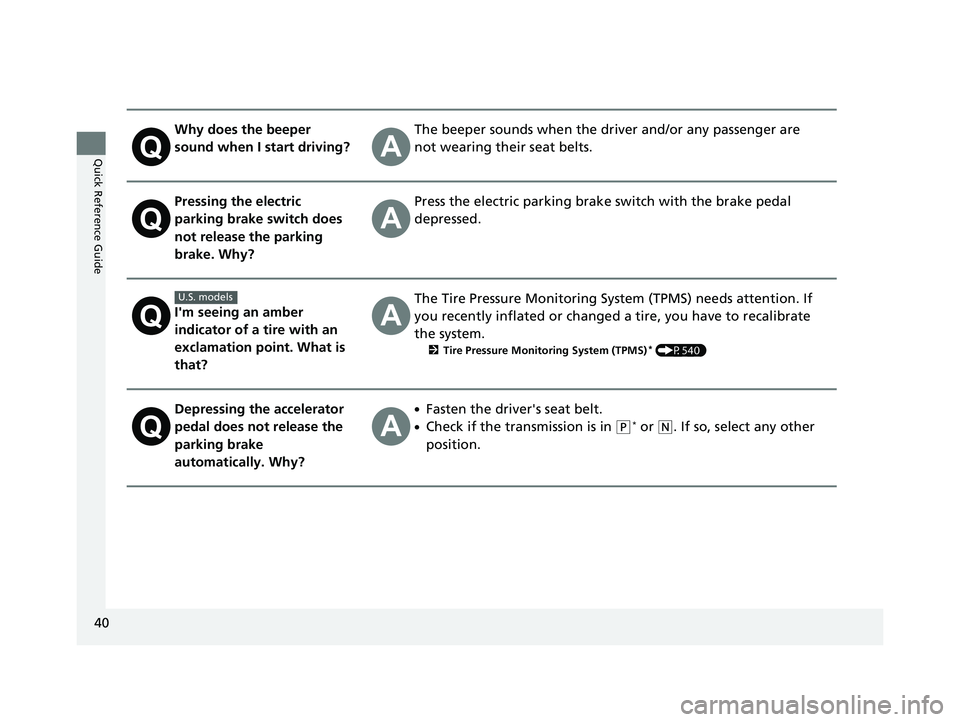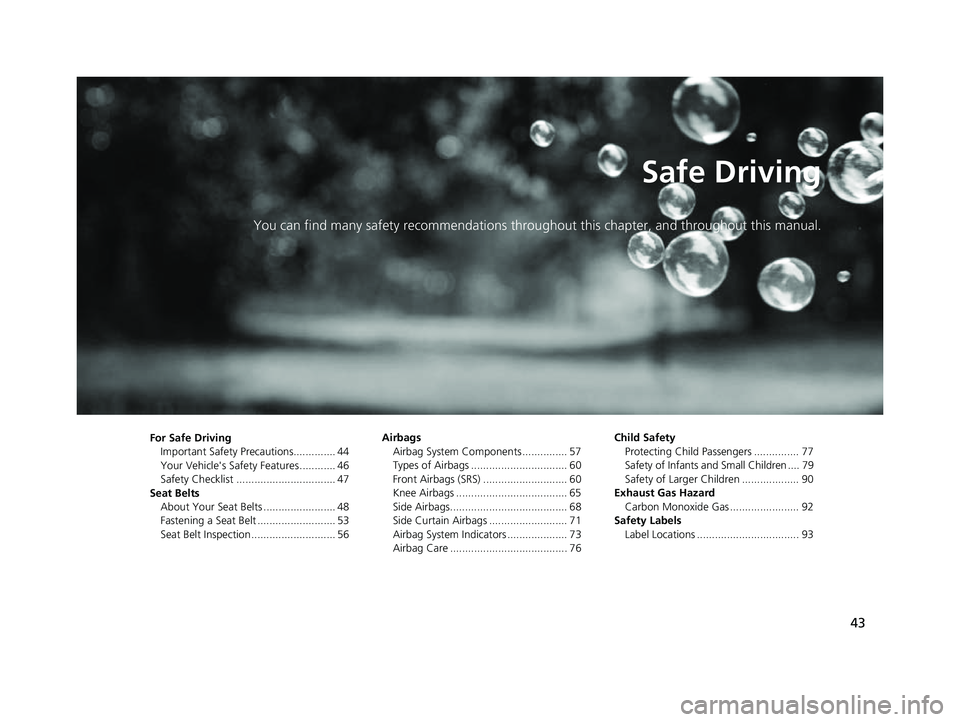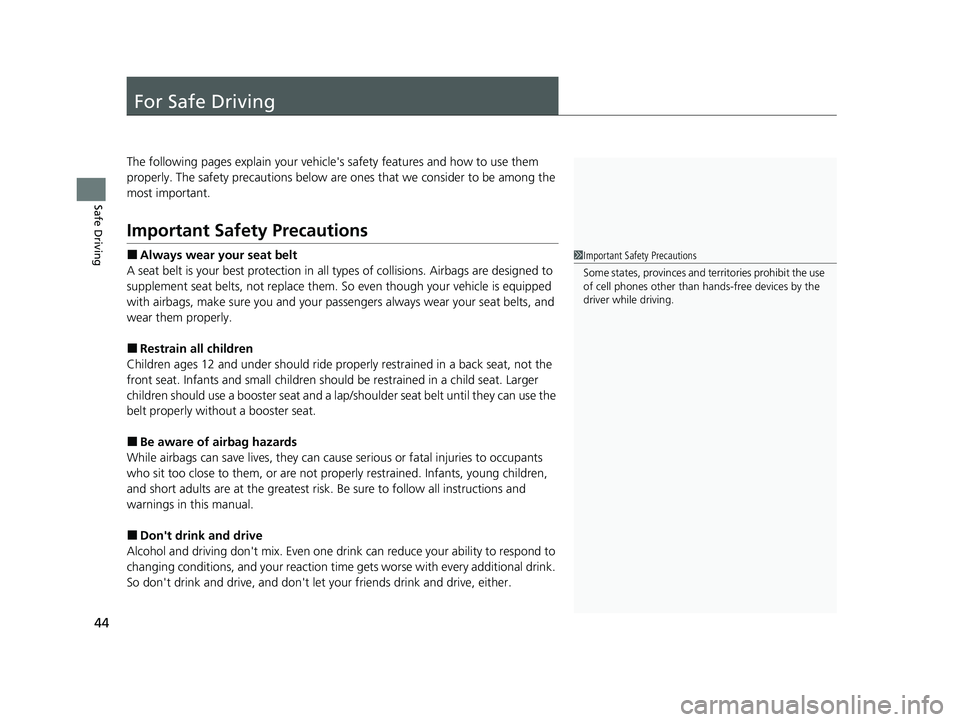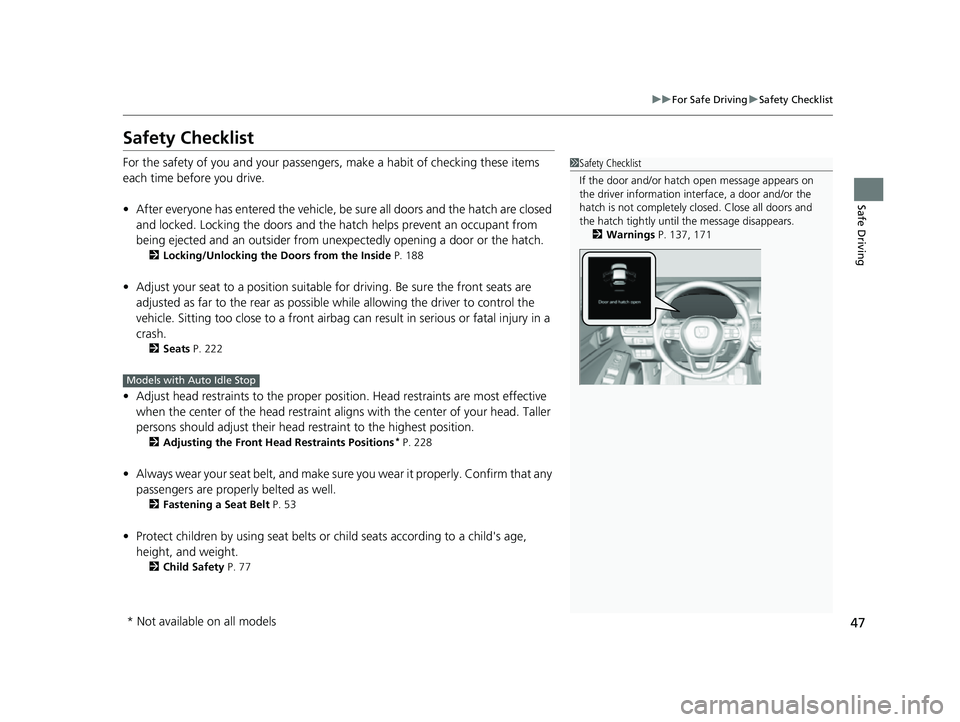2023 HONDA CIVIC Driving
[x] Cancel search: DrivingPage 36 of 840

34
Quick Reference Guide
Honda Sensing® (P551)
Honda Sensing ® is a driver support system
which employs the use of two distinctly
different kinds of sensors: the sonar sensors
located in the front and rear bumpers, and
the front grille, and a front wide view
camera mounted to the interior side of the
windshield, behind the rearview mirror.
Honda Sensing ® is a driver support system
which employs the use of a front wide view
camera mounted to the interior side of the
windshield, behind the rearview mirror.
Models with Low Speed Braking Control
Models without Low Speed Braking Control
Models with Auto Idle Stop
Front Wide View
Camera
Sonar Sensors*
Collision Mitigation
Braking System
TM
(CMBS
TM) (P555)
The system can assist you when it
determines there is a possibility of your
vehicle colliding with a vehicle (including
motorcycles) ahead from behind, an
oncoming vehicle in front, a pedestrian, or
someone riding a bicycle (moving bicycle).
The CMBS
TM is designed to alert you when
the potential for a collision is determined, as
well as assist in reducing speed, avoiding
collisions, and reducing collision severity.
Models without Auto Idle Stop
Front Wide View
Camera
Sonar Sensors*
Low Speed Braking
Control
* (P567)
Using sonar sensors lo cated on the front and
rear bumpers, and the front grille, this
system detects if there is danger of a
potential collision with a wall or other
obstacle during normal driving or when the
accelerator pedal is depressed with too
much force. The system then assists in
avoiding collisions and reducing damage
from impact through assistive braking and/
or assistive driving power suppression.
Low Speed Braking
Control
* (P573)
Using sonar sensors lo cated on the front and
rear bumpers and the front grille, this
system detects if there is danger of a
potential collision with a wall or other
obstacle during normal driving. The system
then assists in avoiding collisions and
reducing damage from impact through
assistive braking.
Continuously variable transmission models
with parking sensor system
Manual transmission models
with parking sensor system
23 CIVIC HATCHBACK TYPE R-31T406100_03.book 34 ページ 2022年6月23日 木曜日 午後9時28分
Page 38 of 840

36
Quick Reference Guide
Maintenance (P691)
Under the Hood (P707)
●Check engine oil, engine coolant, and windshield washer fluid. Add
when necessary.
●Check brake/clutch* fluid.●Check the battery condition monthly.
aPull the hood release handle under the driver's side lower corner
of the dashboard.
bLocate the hood latch lever, push it to the side, and then raise the
hood. Once you have raised the hood slightly, you can release the
lever.
cWhen finished, close the hood and make sure it is firmly locked in
place.
Lights (P728)
●Inspect all lights regularly.
Wiper Blades (P733)
●Replace blades if they leave streaks
across the windshield or become
noisy.
Tires (P736)
●Inspect tires and wheels
regularly.
●Check tire pressures regularly.●Install snow tires for winter
driving.
23 CIVIC HATCHBACK TYPE R-31T406100_03.book 36 ページ 2022年6月23日 木曜日 午後9時28分
Page 42 of 840

40
Quick Reference Guide
Why does the beeper
sound when I start driving?The beeper sounds when the driver and/or any passenger are
not wearing their seat belts.
Pressing the electric
parking brake switch does
not release the parking
brake. Why?Press the electric parking brake switch with the brake pedal
depressed.
I'm seeing an amber
indicator of a tire with an
exclamation point. What is
that?
The Tire Pressure Monitoring Syst em (TPMS) needs attention. If
you recently inflated or changed a tire, you have to recalibrate
the system.
2 Tire Pressure Monitoring System (TPMS)* (P540)
Depressing the accelerator
pedal does not release the
parking brake
automatically. Why?●Fasten the driver's seat belt.
●Check if the transmission is in (P* or (N. If so, select any other
position.
U.S. models
23 CIVIC HATCHBACK TYPE R-31T406100_03.book 40 ページ 2022年6月23日 木曜日 午後9時28分
Page 45 of 840

43
Safe Driving
You can find many safety recommendations throughout this chapter, and throughout this manual.
For Safe Driving
Important Safety Precautions.............. 44
Your Vehicle's Safety Features ............ 46
Safety Checklist ................................. 47
Seat Belts About Your Seat Belts ........................ 48
Fastening a Seat Belt .......................... 53
Seat Belt Inspection ............................ 56 Airbags
Airbag System Components ............... 57
Types of Airbags ................................ 60
Front Airbags (SRS) ............................ 60
Knee Airbags ..................................... 65
Side Airbags....................................... 68
Side Curtain Airbags .......................... 71
Airbag System Indicators .................... 73
Airbag Care ....................................... 76 Child Safety
Protecting Child Passengers ............... 77
Safety of Infants and Small Children .... 79
Safety of Larger Children ................... 90
Exhaust Gas Hazard Carbon Monoxide Gas ....................... 92
Safety Labels Label Locations .................................. 93
23 CIVIC HATCHBACK TYPE R-31T406100_03.book 43 ページ 2022年6月23日 木曜日 午後9時28分
Page 46 of 840

44
Safe Driving
For Safe Driving
The following pages explain your vehicle's safety features and how to use them
properly. The safety precautions below are ones that we consider to be among the
most important.
Important Safety Precautions
■Always wear your seat belt
A seat belt is your best protection in all types of collisions. Airbags are designed to
supplement seat belts, not replace them. So even though your vehicle is equipped
with airbags, make sure you and your passengers always wear your seat belts, and
wear them properly.
■Restrain all children
Children ages 12 and under should ride prop erly restrained in a back seat, not the
front seat. Infants and small children should be restrained in a child seat. Larger
children should use a booster seat and a lap/shoulder seat belt until they can use the
belt properly without a booster seat.
■Be aware of airbag hazards
While airbags can save lives, they can cause serious or fatal injuries to occupants
who sit too close to them, or are not prop erly restrained. Infants, young children,
and short adults are at the greatest risk. Be sure to follow all instructions and
warnings in this manual.
■Don't drink and drive
Alcohol and driving don't mix. Even one dr ink can reduce your ability to respond to
changing conditions, and your reaction time gets worse with every additional drink.
So don't drink and drive, and don't let your friends drink and drive, either.
1Important Safety Precautions
Some states, provinces and te rritories prohibit the use
of cell phones other than hands-free devices by the
driver while driving.
23 CIVIC HATCHBACK TYPE R-31T406100_03.book 44 ページ 2022年6月23日 木曜日 午後9時28分
Page 47 of 840

45
uuFor Safe Driving uImportant Safety Precautions
Safe Driving
■Pay appropriate attention to the task of driving safely
Engaging in cell phone conversation or other activities that keep you from paying
close attention to the road, other vehicles , and pedestrians could lead to a crash.
Remember, situations can change quickly, and only you can decide when it is safe to
divert some attention away from driving.
■Control your speed
Excessive speed is a major factor in crash injuries and deaths. Generally, the higher
the speed, the greater the risk, but serious injuries can also occur at lower speeds.
Never drive faster than is safe for current conditions, regardless of the maximum
speed posted.
■Keep your vehicle in safe condition
Having a tire blowout or a mechanical failure can be extremely hazardous.
To reduce the possibility of such problems, check your tire pressures and condition
frequently, and perform all re gularly scheduled maintenance.
■Do not leave children unattended in the vehicle
Children, pets, and people needing assistance left unattended in the vehicle may be
injured if they activate one or more of the vehicle controls. They may also cause the
vehicle to move, resulting in a crash in wh ich they and/or another person(s) can be
injured or killed. Also, depending on the am bient temperature, the temperature of
the interior may reach extreme levels, which ca n result in harm or death. Even if the
climate control system is on, never leave them in the vehicle unattended as the
climate control system can shut off at any time.
23 CIVIC HATCHBACK TYPE R-31T406100_03.book 45 ページ 2022年6月23日 木曜日 午後9時28分
Page 48 of 840

46
uuFor Safe Driving uYour Vehicle's Safety Features
Safe Driving
Your Vehicle's Safety Features
The following checklist will help you take an active role in protecting yourself and
your passengers.
1 Your Vehicle's Safety Features
Your vehicle is equipped wi th many features that
work together to help protect you and your
passengers during a crash.
Some features do not require any action on your part.
These include a strong steel framework that forms a
safety cage around the passenger compartment,
front and rear crush zones, a collapsi ble steering
column, and tensioners th at tighten the front and
rear outer seat belts in a sufficient crash.
However, you and your passe ngers cannot take full
advantage of these features unless you remain seated
in the correct position and always wear your seat
belts. In fact, some safety features can contribute to
injuries if they are not used properly.
67891011
Safety Cage
Crush Zones
Seats and Seat-Backs
Head Restraints
Collapsible Steering Column
Seat Belts
Front Airbags
Side Curtain Airbags
Door Locks Side Airbags
Seat Belt Tensioners7
79
9
8
10
6
11
Outer Lap Pretensioners Knee Airbags12
13
10
12
13
9
11
12
8
23 CIVIC HATCHBACK TYPE R-31T406100_03.book 46 ページ 2022年6月23日 木曜日 午後9時28分
Page 49 of 840

47
uuFor Safe Driving uSafety Checklist
Safe Driving
Safety Checklist
For the safety of you and your passengers, make a habit of checking these items
each time before you drive.
• After everyone has entered the vehicle, be sure all doors and the hatch are closed
and locked. Locking the doors and the hatch helps prevent an occupant from
being ejected and an outsider from unexpectedly opening a door or the hatch.
2 Locking/Unlocking the Doors from the Inside P. 188
•Adjust your seat to a position suitable for driving. Be sure the front seats are
adjusted as far to the rear as possible while allowing the driver to control the
vehicle. Sitting too close to a front airbag can result in serious or fatal injury in a
crash.
2 Seats P. 222
•Adjust head restraints to the proper position. Head restraints are most effective
when the center of the head restraint alig ns with the center of your head. Taller
persons should adjust their head restraint to the highest position.
2 Adjusting the Front Head Restraints Positions* P. 228
•Always wear your seat belt, and make sure you wear it properly. Confirm that any
passengers are properly belted as well.
2 Fastening a Seat Belt P. 53
•Protect children by using seat belts or child seats according to a child's age,
height, and weight.
2 Child Safety P. 77
1Safety Checklist
If the door and/or hatch open message appears on
the driver information inte rface, a door and/or the
hatch is not completely cl osed. Close all doors and
the hatch tightly until the message disappears.
2 Warnings P. 137, 171
Models with Auto Idle Stop
* Not available on all models
23 CIVIC HATCHBACK TYPE R-31T406100_03.book 47 ページ 2022年6月23日 木曜日 午後9時28分